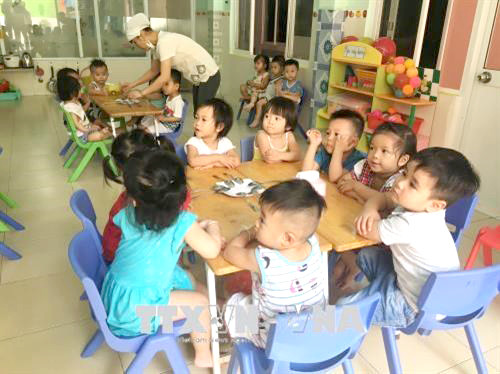Since2016, the city has allocated more than 17 trillion VND (731.9 million USD) foreducation and training development, according to the municipal Department ofEducation and Training.
Thanksto the fund, the city has created nearly 1,500 new classrooms each year,including 300 for pre-school education.
LeHong Son, Director of the city’s Department of Education and Training, said therate of children aged 1-3 going to kindergarten accounts for 31 percentand 86 percent for those aged 4-5.
Thecity provides compulsory pre-school education for 99.6 percent of 5-year-oldchildren.
Thecity aims to provide compulsory pre-school education for 4-year-oldchildren, Son said.
Thecity’s kindergartens are continuing to provide services during extrahours for workers at industrial park and export processing zones.
Educationreform at many kindergartens has placed more emphasis on creativity andthinking skills, he said, adding that STEM (science, technology, engineeringand mathematics) education is also provided.
Manypublic kindergartens have called for investment from the private sector tobuild Robot technical rooms, applied science rooms, technicalplaygrounds and others to create a stimulating environmentfor children to practise, Son said.
Thecity has 181 standard kindergartens and 16 others working towardan advanced model with high standards, he added.
However,the number of classrooms has failed to meet demand, andthe number of children in each classroom is still too high. The city has nearly 880 private kindergartens.
LeThi Oanh, head of the education and training division in Nha Be district, saidthe district’s economy is developing rapidly and attracting a large number ofworkers, leading to challenges in ensuring a sufficient number of kindergartensand other schools for children. The district has 90 kindergartens, ofwhich 13 are public.
PhanThi Kim Duyen, deputy head of district 9’s education and training division,said the district has more than 60 public and private kindergartens.
Duyen saidthat nearly 60 percent of more than 17,000 children in the district aretaken care of at private kindergartens and nurseries.
KhuuManh Hung, head of the district 12's education and training division, said thatprivate kindergartens helped their public counterparts reduce the numberof children in each classroom and increased the rate of pre-schoolenrollment in the district. The district has 337 private and publicpre-schools.
InThu Duc district, the number of pre-school-aged children is increasing,creating pressure on classrooms. The number of public kindergartens in thedistrict meets only 40 percent of demand. Private kindergartens andnurseries take care of the remaining 60 percent.
Oanhof Nha Be district said that district authoritieshad provided equipment and facilities to small privatenurseries and trained teachers regularly.
Manyother districts have asked the city’s committee to issue preferentialpolicies for public pre-schools. The city should lease land for long periodsand build kindergartens at preferential prices, especially in areas withindustrial parks where workers need schools for their children, they said.
Theneed for private kindergartens is also high, but issues relating to landhave prevented investors from expanding their kindergartens and building newones.
Accordingto a city regulation, land for building kindergartens has to be includedin the planning for the educational sector.
Oanhsaid the city has not had preferential tax policies for kindergartens.Most of them have to rent facilities at high prices, so the school feesmust be high. The fee deters parents from sending their children tothese kindergartens.
Duyenof district 9 said that more small private nurseries have opened, leading tomanagement difficulties because of the low number of division staff.The nurseries’ teachers and staff often change, leading totraining and quality issues, although the division has a team to assist intraining, she said.
HCMCity's project on pre-school education development in the 2019-2025period aims to improve quality and develop kindergartens andnurseries to ensure that at least 35 percent of children aged 1-3 and 95 percentof children aged 4-5 will attend.
Underthe plan, the rate of private pre-school establishments would account formore than 60 percent by 2025./.





























